Butternut squash is a versatile vegetable with tons of nutritional benefits. Here are our tips on how to cook butternut squash, spices and flavors that go well with them, as well as some Scramble recipes to get you started.
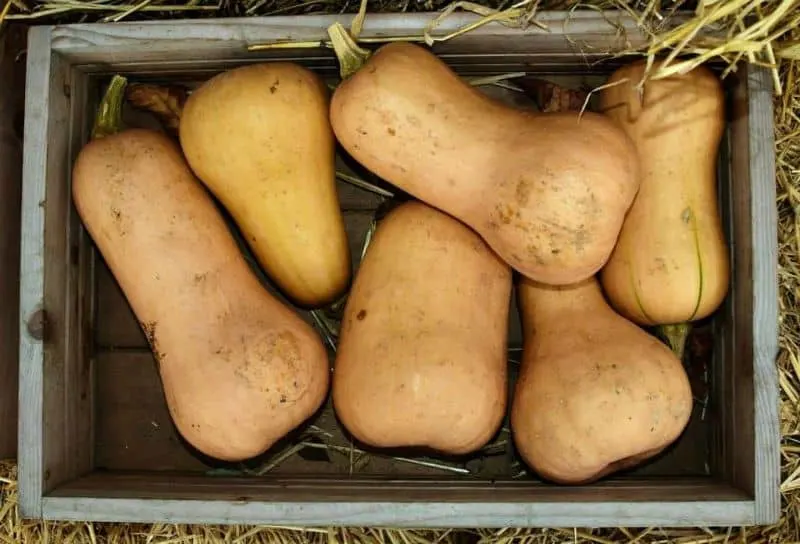
How to Cook Butternut Squash and Recipes to Get You Started
Growing up we didn’t eat much winter squash because my dad isn’t a huge fan. This meant that I didn’t discover the joys of all of the different varieties until well into adulthood. I started my squash cooking journey with the most well-known of the winter squashes: butternut. As many do, I started with a soup recipe, but quickly learned that there are many ways to enjoy this amazing vegetable (actually a fruit, but we usually think of it as a veggie).
To help you to take advantage of all that they have to offer, here are tips on how to cook butternut squash as well as recipes to get you started.
Why Eat Butternut Squash?
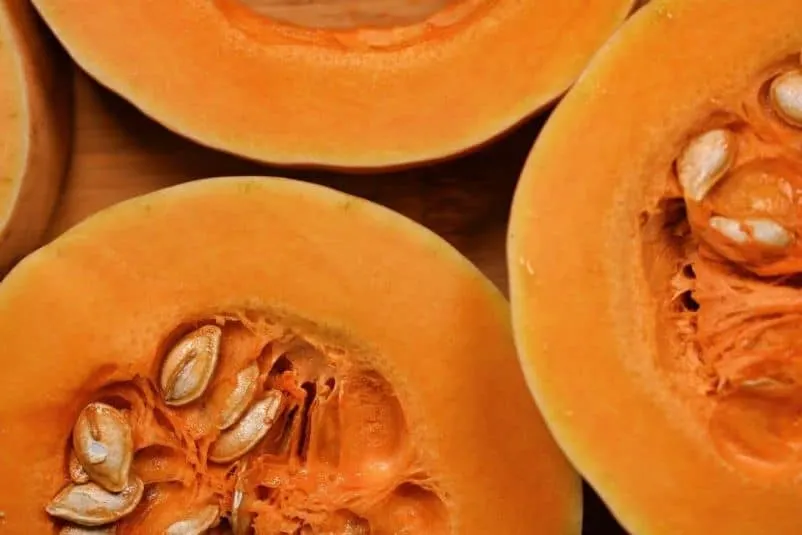
First and foremost, butternut squash is delicious! It has a slightly sweet and vaguely nutty flavor that makes it an extremely versatile ingredient.
In addition, butternut squash offers a ton of nutritional benefits. First and foremost, it is a Vitamin A monster, offering up over 400% of your referenced daily intake (RDI). This is important because Vitamin A supports bone and eye health, as well as your immune system.
The bone health benefits don’t stop with the Vitamin A either because it turns out the butternut squash is also a great source of magnesium, potassium, and manganese. It also offers up Vitamin E which is great for reducing the risk of age-related conditions and Vitamin B, which is great for energy.
Finally, it has over 50% of your Vitamin C RDI – again making it a winner in fighting off colds.
Flavor Partners
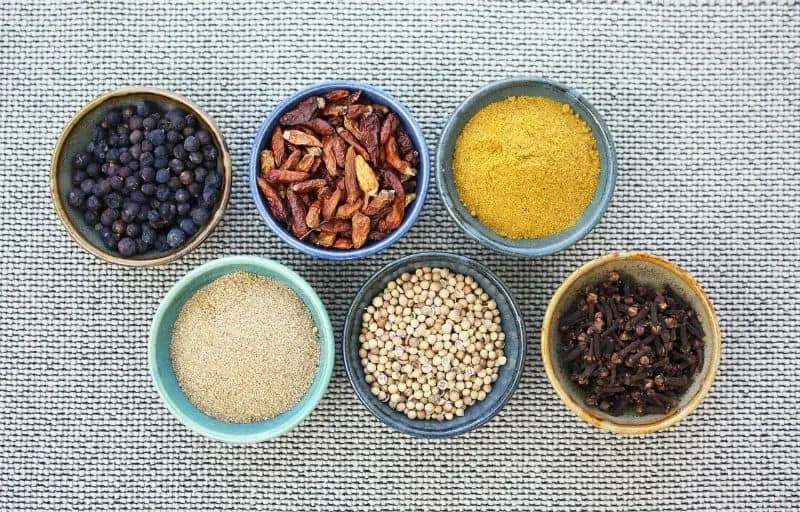
As mentioned above, one of the things that makes butternut squash so fantastic is that it is incredibly versatile, both in terms of what you can make with it, but also in terms of all of the different flavors you can add. Here are lists of both.
What you can make with butternut squash
- Soup
- Stews
- Risottos
- Casseroles
- Bites- either steamed or roasted
- Mash
Some flavors and foods that go well with butternut squash include
- Allspice
- Chili powder
- Cinnamon
- Nutmeg
- Rosemary
- Sage
- Thyme
- Garlic
- Ginger
- Lemon
- Lime
- Chili peppers
- Maple syrup
- Honey
- Goat cheese
- Ricotta cheese
- Parmesan cheese
- Coconut milk (in soups and stews)
- Bacon
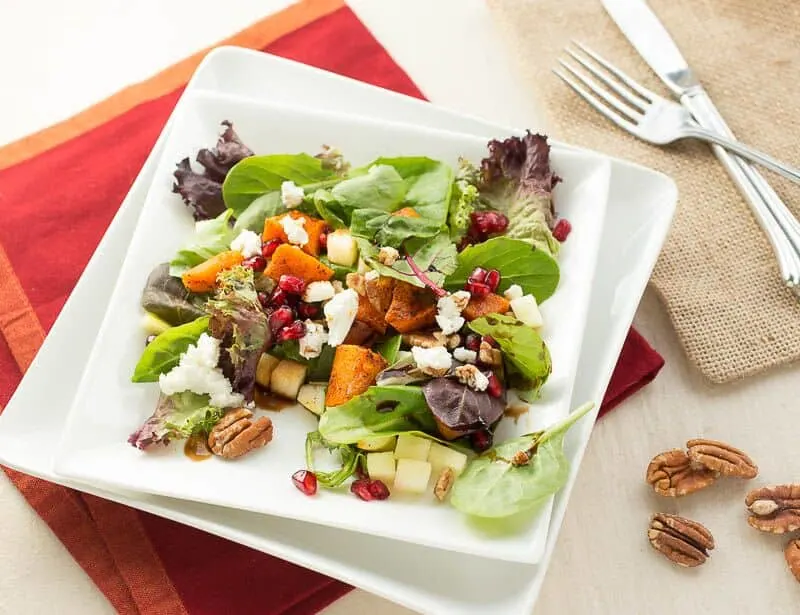
How to Cook Butternut Squash
The first step in cooking butternut squash is to prepare it. When I first started working with butternut squash I found the hardness of the squash and the peeling to be pretty overwhelming. I spent hours fighting my knife through and trying to get the peel off, until I learned some tricks.
Step 1: Peeling the Squash
There are two options here, depending on what your end product will be.
If you are going to be roasting and then pureeing the squash (for soups or mashes), then just cut the squash in half, scrape out the seeds, roast (see directions below), and then scoop the flesh out once the squash is cooked.
If you are going to be dicing the squash, then start by making your squash easier to work with by cutting a small portion (about ½-inch) off of the top and bottom of the squash. This will make it easier to handle.
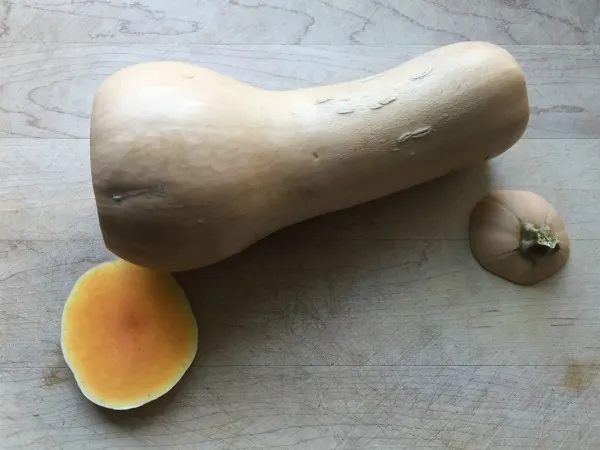
Then, cut the butternut squash just above the bulb, so that you have two pieces: one that is longer and solid and one that is rounder and has the seeds inside.
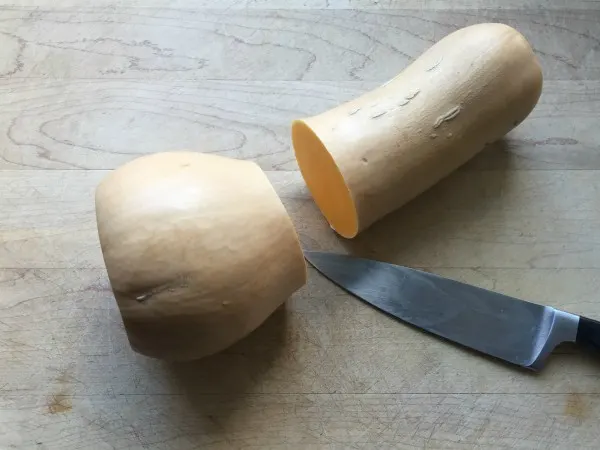
Now you peel. Some people like to use a paring knife, but I prefer to use my vegetable peeler, as I find it is easier to use. As you peel, do you best to remove all of the peel so that the fibrous green under layer disappears and you are only left with the orange flesh.
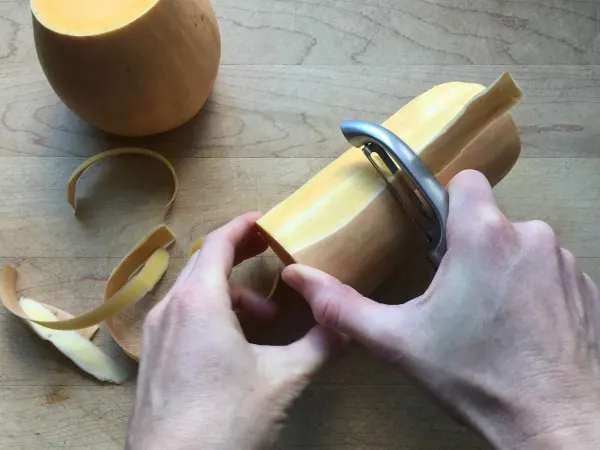
Step 2: Dicing the squash
The two sections of the squash will be diced differently.
For the long, solid piece, stand it on its end and slice lengthwise in as thick slices as you want the cubes to be (1/2-inch to 1-inch).
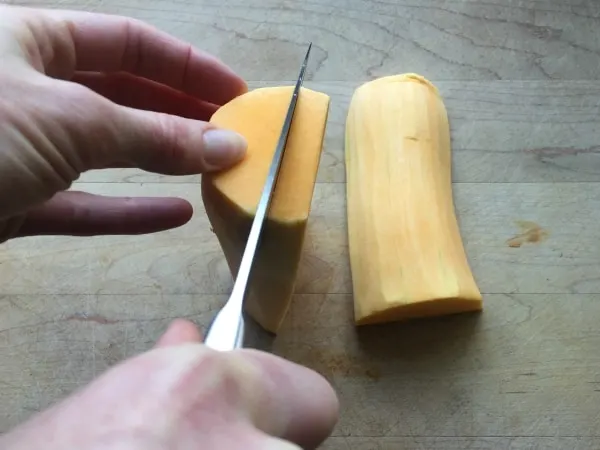
Then lay the slices down and cut lengthwise, again, in as thick slices as you want the cubes to end up.
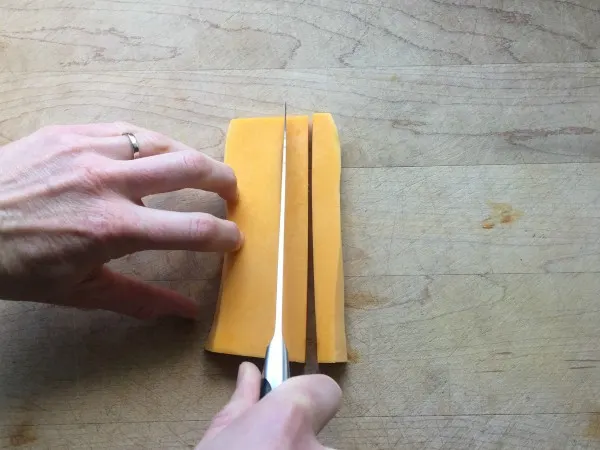
You then will have strips of butternut squash, which you can chop horizontally to get the final dice.
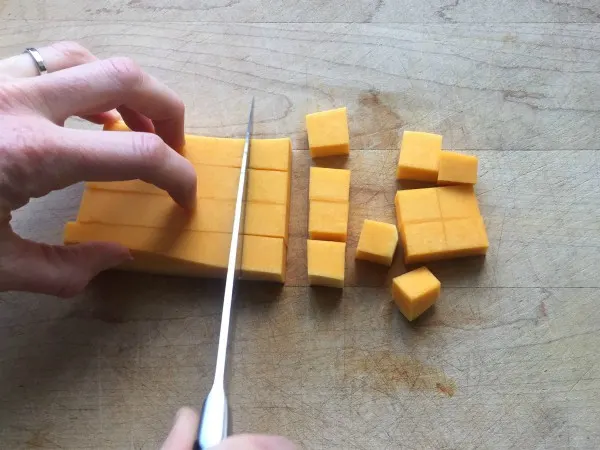
For the round piece, start by cutting it in half. Then, scoop out the seeds (and save for roasting! See below).
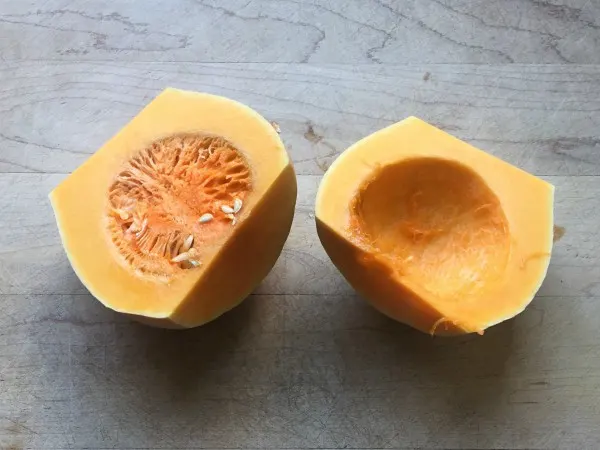
You will find yourself with two half sphere-like shapes. Turn them over so that they are hollow-side down and slice into slices that are as thick as the ones described above. You will end up with crescent-shaped slices.
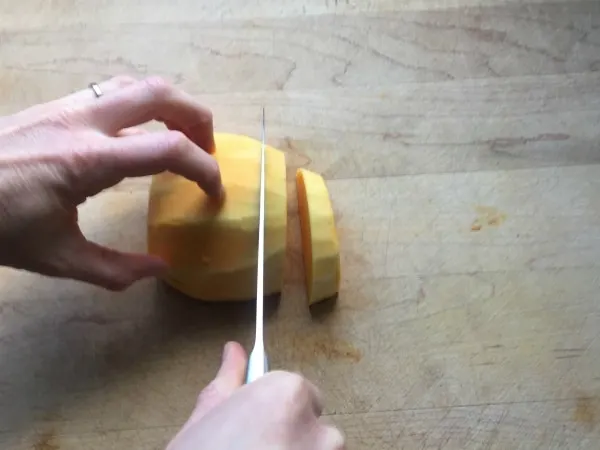
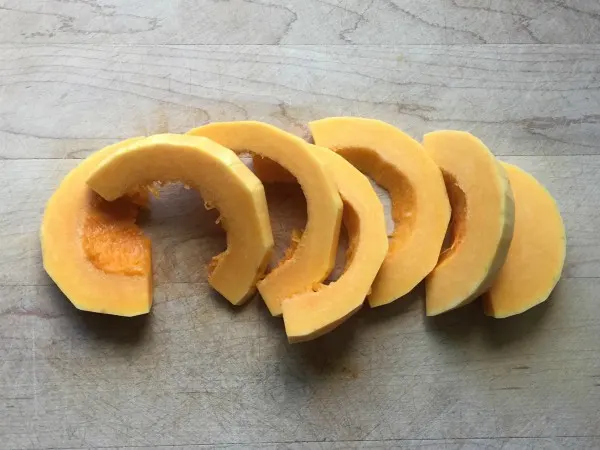
Then chop these crescents into the size of dice that you desire. And you are done!
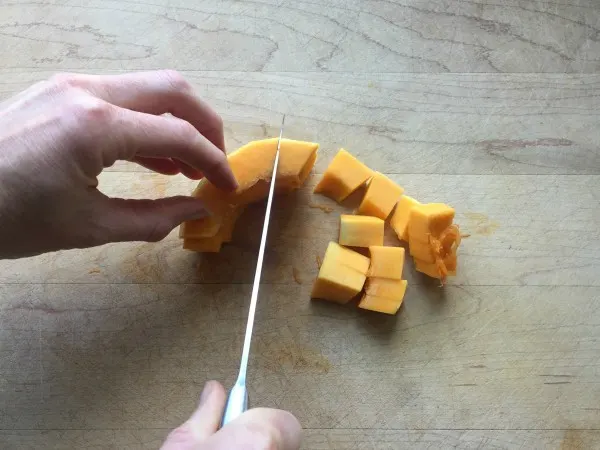
How to Cook Butternut Squash
There are many ways to enjoy butternut squash in your meals.
Raw
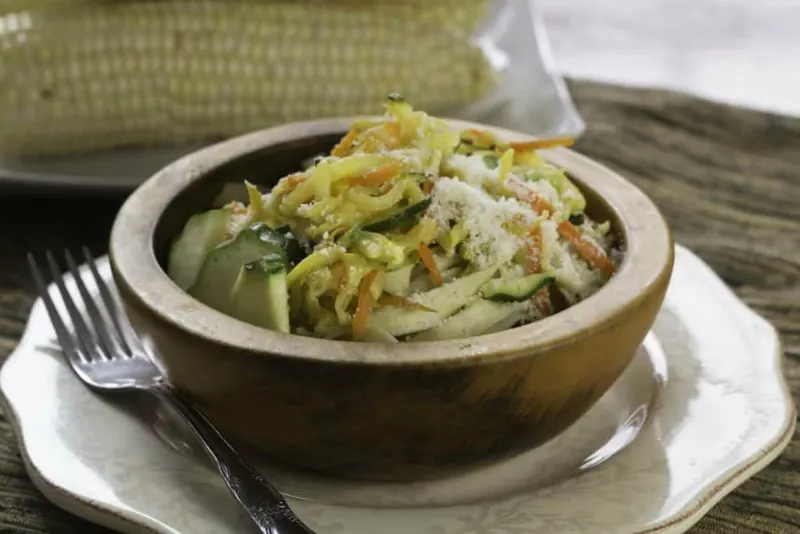
While usually served cooked, especially since cooking brings out its sweetness, butternut squash is safe to eat raw and can be shredded and added to things like salads and summer rolls.
Steamed
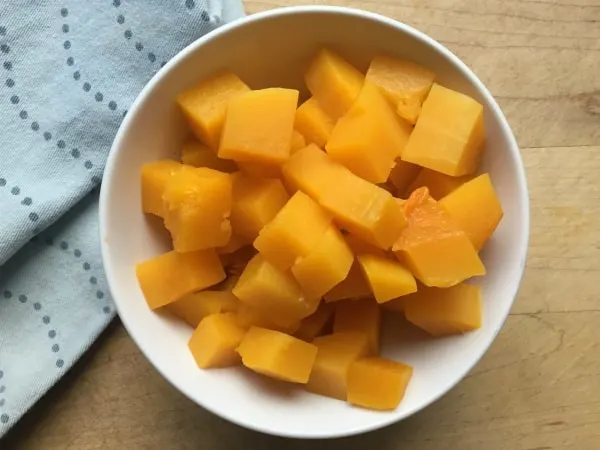
This is a super simple preparation of butternut squash. Once steamed, you can add the diced squash to salads, casseroles, wraps, risottos, or serve it as a simple side dish (it is delicious topped with some butter, salt, pepper, and Parmesan cheese).
To steam butternut squash: put 1 or so inches of water into the bottom of a large pot and then fit it with a steamer basket. Bring the water to a boil, then add the squash to the basket. Cover and steam for 10-15 minutes (depending on size of dice), until fork tender.
Roasting Butternut Squash Halves
To roast butternut squash halves, preheat the oven to 350. Brush the cut sides with extra virgin olive oil, place cut-side down on the baking sheet, and bake for about an hour. Check for doneness at around 45 minutes. You will know the squash is fully cooked when a fork can easily pierce through the skin and flesh. The skin may, at this point, be brown and blistered – that is ok! You can then scoop out the flesh and use in soups or mash it up for a delicious side dish.
Roasted Diced Butternut Squash
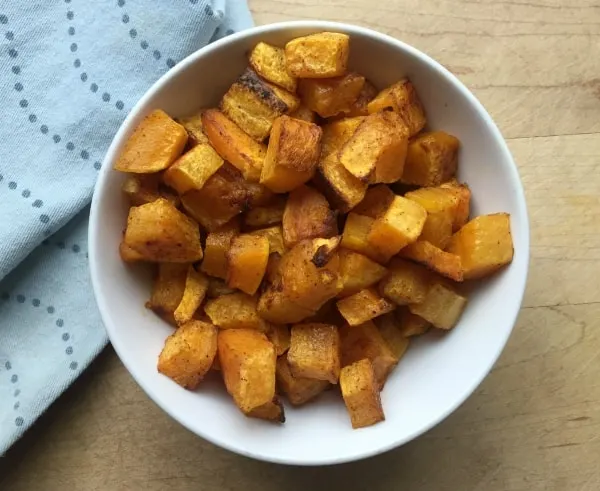
This is my favorite preparation because roasting brings out the natural sugars in the squash and adds a nutty and carmel-y quality it. Yum!
To roast your diced butternut squash: preheat the oven to 425 degrees and lightly oil a baking sheet (use two baking sheets if you are roasting an entire diced butternut squash) or line it with parchment paper (for easy clean up). In a large bowl, toss the diced squash with extra virgin olive oil, salt, and pepper (and/or add some of the herbs and spices mentioned above). Then lay the squash out in one, even layer on the baking sheet and bake for 25 – 30 minutes, or until fork tender and starting to brown on the outside.
Serve as is or mix into salads, casseroles, burritos, etc.
Mashed
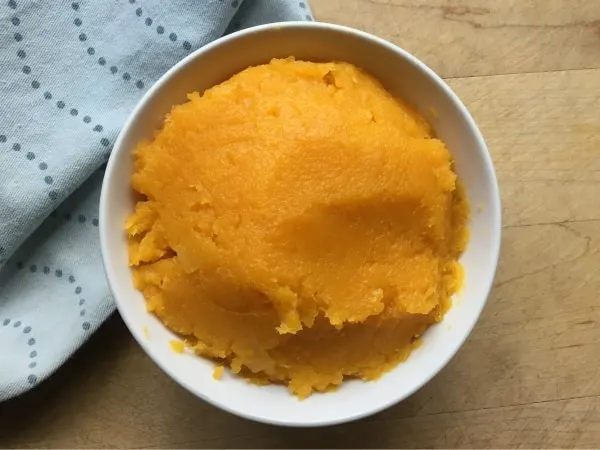
Just take either steamed or roasted butternut squash and mash it as you would mashed potatoes. This is a delicious side dish. Serve topped with butter and spices of your choice.
Soups
Butternut squash soup is a classic. You can make it using either already cooked squash or raw squash that you cook in the stock (see below for recipes).
Stews and Chilis
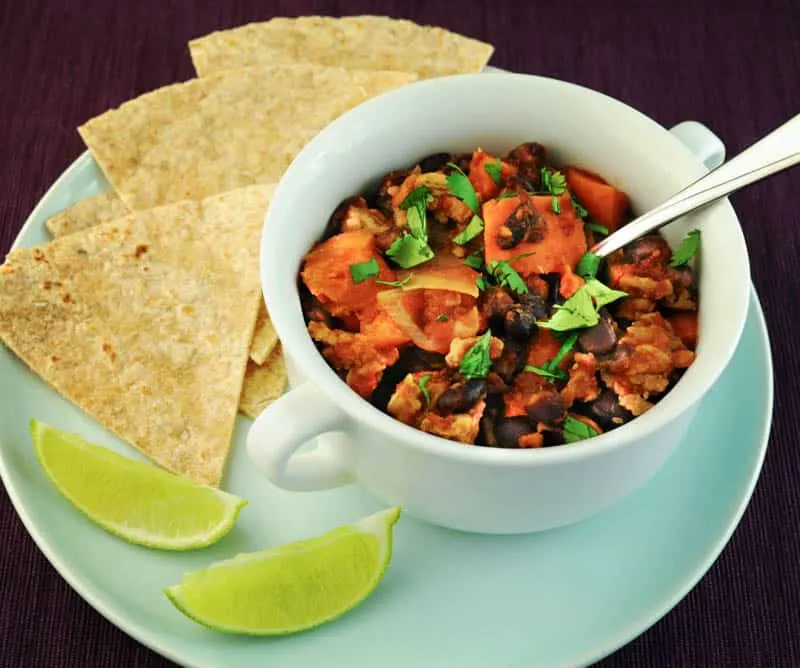
Butternut squash adds a wonderful, gentle sweetness to stews and chilis. Just add diced butternut squash in raw and allow it to soften in the stew/chili (usually about 10 – 15 minutes).
Enjoying the Seeds
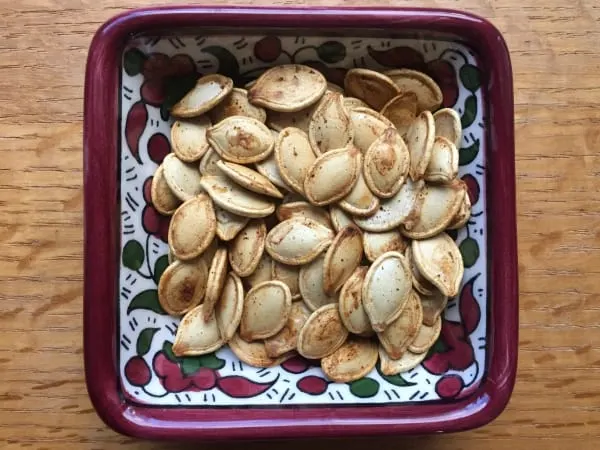
As mentioned above, butternut squash seeds are delicious and make a fantastic snack or topping for soups and stews! Here’s how to prepare them:
- Preheat the oven to 300 degrees and line a baking sheet with parchment paper.
- Place the seeds into a mixing bowl and cover them with water.
- Use your fingers to separate the seeds from the fibrous, stringy stuff.
- Drain the seeds in a strainer and pull off any remaining orange stringy stuff.
- Dry the seeds with a clean dish towel or paper towel.
- Place in a bowl and toss with some extra virgin olive oil, salt, and spices, if desired. I love chili powder here!
- Lay the seeds out on the baking sheet in a single layer and bake for 15 – 20 minutes, until you can hear them popping.
- Cool and serve (they will crisp up more as they cool).
Recipes to Get You Started
Here are some Scramble recipes that will help you to enjoy all that butternut squash.
Butternut Squash and Apple Soup with Crispy Sage
This soup is warming and comforting with its lovely balance of sweet and savory. The quintessential fall soup. And it can be made in the slow cooker, too!
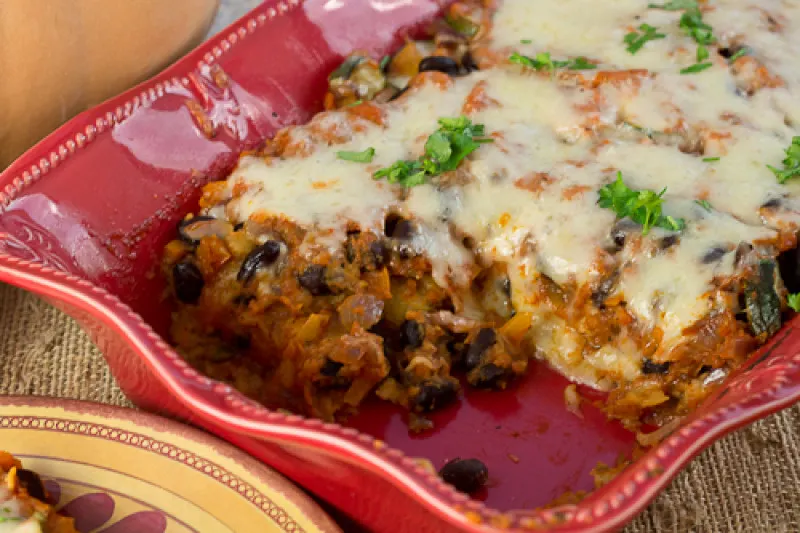
Stacked Enchiladas
This shortcut version of enchiladas has all the creamy, comforting deliciousness of enchiladas without all the work of rolling! A weeknight favorite in my house.
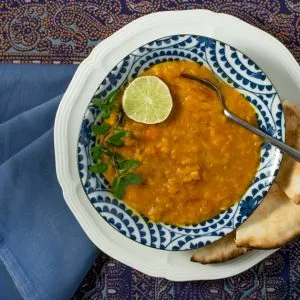
Butternut Squash and Yellow Lentil Stew
Ingredients
- 2 Tbsp. coconut or vegetable oil
- 1 sweet yellow onion such as Vidalia or Walla Walla, diced
- 1 Tbsp. fresh ginger peeled and minced
- 2 cloves garlic minced, about 1 tsp.
- 1 tsp. turmeric
- 1 tsp. curry powder
- 6 – 8 cups butternut squash peeled, seeded and diced (about 2 lbs.)
- 1 cup yellow split peas or use yellow or red lentils, you can use green split peas if you can’t find any of these
- 15 oz. diced tomatoes with their liquid
- 32 oz. reduced-sodium vegetable or use chicken broth, warmed
- 1 lime cut into wedges, for serving
Instructions
- Heat a Dutch oven or large stockpot over medium heat, add the oil, and when it is hot, add the onions and ginger. Cook it for about 3 minutes until the onions are translucent.
- Stir in the garlic, turmeric and curry powder for about 30 seconds, then add the butternut squash, split peas or lentils, tomatoes, and broth, cover, and bring it to a boil.
- Reduce the heat and simmer it, covered, for 30 minutes, stirring occasionally.
- Uncover it and let it simmer for 10 more minutes or until the peas/lentils are tender.
- Using an immersion blender or a standing blender, puree the stew to desired consistency (we like it a little chunky, one tester preferred it smooth). Serve it immediately, with freshly squeezed lime, or refrigerate it for up to 3 days, or freeze it for up to 3 months.
Slow Cooker Directions:
- You will need at least a 5 quart slow cooker to make this recipe. Omit the oil. Combine all remaining ingredients in the slow cooker and cook on low for 8 – 10 hours, or on high for 4 – 5 hours. (Slow cooker cooking times may vary—Get to know your slow cooker and, if necessary, adjust cooking times accordingly.)
Notes
Nutrition
Do you have other tricks to cook butternut squash or favorite recipes? I’d love to hear about them in the comments! Curious about other winter squashes? Check out my similar post on acorn squash!
Like these recipes and techniques? Sign up for a free trial of The Scramble to see how simple feeding yourself and your family can be!

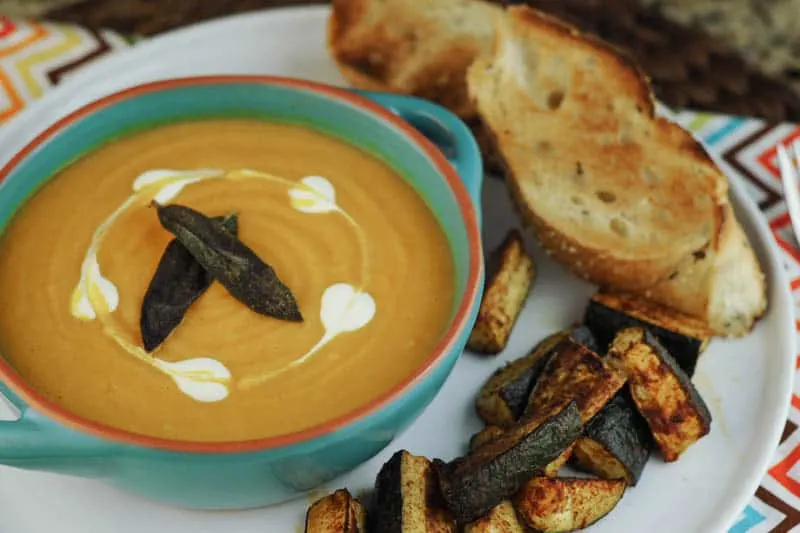
Root Vegetables: How to Store, Nutritional Info, and Recipes
Tuesday 5th of December 2023
[…] How to Cook Butternut Squash and Recipes to Get You Started […]
Roasted Delicata Squash with Feta and Pomegranate
Thursday 9th of November 2023
[…] out the seeds (which you can save to roast, if […]
How to Cook Acorn Squash and Recipes to Get You Started
Wednesday 16th of November 2022
[…] and foremost, acorn squash is delicious! It has a slightly sweet (I find it is less sweet than butternut squash), earthy, and nutty flavor that makes it an extremely versatile […]